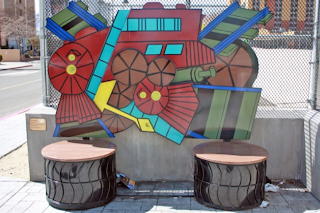Chester Arnold was born in Santa Monica, California in 1952. He received private schooling from 1966 to 1970 in Munich, Germany and soon after he attended College at Marin in Kentfield, California for four years. He later received an M.F.A. from the San Franscisco Art Institute in 1987. He was influenced by German painters such as Caspar Friedrich and Albrecht Altdorfer. His first couple of artwork he painted were based the transformation of Cities and Landscapes by the effects of comtemporary culture. As far as his most recent paintings, they are based on his concerns of exploration and exploitation that humanity are having on the environment.
I have never been to an Art Museum before or did I know that there was one here in Reno of all places.When Candace Nicol announced that the class was going on a field trip to the Nevada Museum of Art, I got excited because it's been a long time since I've been on field trip. The day finally arrives to meet at the Art Museum. As I walk into Chester Arnold's " On Earth as it is in Heaven" exhibit, I was overwhelmed with excitement kind of like a little kid at a candy store. I didn't know where to start, so I ventured off into the Artists mind as i scan through his artwork from portrait to potrait. To my surprise, his oil paintings at first glance seemed rather simplistic and hollow with not much to it.
That all changed when I walked upon an oil painting that got my attention and interested me called "Thy Will be Done" respectively. It stood out from the rest because of the graphic and dark nature of it. There was so much to comprehend that I had to take a step back and dissect each individuals' action in the painting. At first glance I thought of the Holocaust because of the pit in the painting where the jews were burned and buried in. I later found out when I actually started to do research on Chester Arnold that he drew inspiration from the German Expressionists' shift to naturalism during the same time that the Holocaust began. However once I opened my mind and started to look at the big picture, I realized there was more to it than meets the eye. The scenery is that of a baron muddy wasteland with little foliage or signs of life other than the people of course. There were people in body bags being carried inside storage trailers to be dumped in the pit, there were also drunken men, construction workers, slaves, basically people from all walks of life.
To me it was evident that the painting "Thy Will be Done" depicts complete chaos. A world without order and no sense of direction. It speaks out how dim the future for humanity would end up looking like if we don't change our ways. I understand that there is an end to everything when the time comes, but it seems to me we are only speeding up the process and taking everything else with us. When our time comes that's when the world ends.
Sources:
1. Nevada Museum of Art
2.
http://lindahodgesgallery.com/artists/arnold.html
3.
http://tamarind.unm.edu/bios/arnoldbio.html





